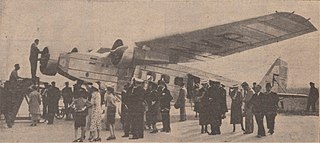
The MB.200 was a French bomber aircraft of the 1930s designed and built by Societé des Avions Marcel Bloch. A twin-engined high-winged monoplane with a fixed undercarriage, over 200 MB.200s were built for the French Air Force, and the type was also licence built by Czechoslovakia, but it soon became obsolete, and was largely phased out by the start of the Second World War.

The Foudre was a French seaplane carrier, the first in history. Her development followed the invention of the seaplane in 1910 with the French Le Canard.

The Arado 95 was a single-engine reconnaissance and patrol biplane designed and built by the German firm Arado in the late 1930s. Ordered by Chile and Turkey, a number were taken over by the Kriegsmarine when World War II started.

The ANF Les Mureaux 110 and its derivatives were a family of French reconnaissance aircraft developed in the 1930s. They were all-metal, parasol-wing monoplanes that seated the pilot and observer in tandem open cockpits. The aircraft were widely used in the Battle of France, but were all scrapped soon thereafter.

The Dewoitine D.27 was a parasol monoplane fighter aircraft designed by Émile Dewoitine in 1928.

The Bloch MB.120 was a French three-engine colonial transport aircraft built by Société des Avions Marcel Bloch during the 1930s.
The Potez XV was a French single-engine, two-seat observation biplane designed as a private venture by Louis Coroller and built by Potez and under licence in Poland.

The CAMS 30E was a two-seat flying boat trainer built in France in the early 1920s. It was the first aircraft designed for CAMS by Raffaele Conflenti after he had been recruited by the company from his previous job at Società Idrovolanti Alta Italia (SIAI). It was a conventional design for the era featuring a two-bay equal-span unstaggered biplane wing cellule. The prototype was exhibited at the 1922 Salon de l'Aéronautique and evaluated the following year by the Aéronautique Maritime. The type's favourable performance led to an order of 22 machines for the French military and an export order of seven for Yugoslavia and four for Poland.

The Potez 540 was a French multi-role aircraft of the 1930s. Designed and built by Potez, it served with the French Air Force as a reconnaissance bomber, also serving with the Spanish Republican Air Force during the Spanish Civil War. Although obsolete as a bomber, it remained in service in support roles and in France's overseas colonies at the start of World War II.

The Loire 46 was a French single-seater fighter aircraft of the 1930s. A high-winged monoplane designed and built by Loire Aviation, it was purchased by the French Air Force. It was also supplied to the Spanish Republican forces during the Spanish Civil War, but was almost out of service by the outbreak of World War II.

The Dewoitine D.1 was a French single-seat fighter aircraft of the 1920s, built by the French industrial company Dewoitine.

The Caproni Ca.73 was an Italian airliner produced during the 1920s which went on to serve as a light bomber in the newly independent Regia Aeronautica. It was an inverted sesquiplane with a biplane tail and two engines mounted in a push-pull configuration within a common nacelle mounted on struts in the interplane gap above the fuselage. The two pilots sat in an open cockpit, while ten passengers could be accommodated within the fuselage.

The Caudron C.440 Goéland ("seagull") was a six-seat twin-engine utility aircraft developed in France in the mid-1930s.

The Dewoitine D.21 was 1920s French open-cockpit, fixed-undercarriage monoplane fighter aircraft.

Île Tintamarre is a small island with an area of approximately 0.8 square kilometres (0.3 sq mi). It is located in the Caribbean Sea, about 3 kilometres (2 mi) from the island of Saint Martin, and is administered as part of the French overseas collectivity of Saint Martin. The island has no human occupants, but has been inhabited in the past. Between 1946 and 1950, it was the base for the airline Compagnie Aérienne Antillaise, which flew planes from the island's 500-metre (1,600 ft) airstrip

The Wibault 7 was a 1920s French monoplane fighter designed and built by Société des Avions Michel Wibault. Variants were operated by the French and Polish military and built under licence for Chile as the Vickers Wibault.

The Starck AS-70 Jac is a French-built single-seat light aircraft of the mid-1940s.
Groupe de Chasse or groupe de chasse is the French language term for "fighter group" or "fighter wing". More literal translations include "pursuit group" and "hunting group".

Escadron de Chasse is a French Air and Space Force fighter squadron currently stationed at BA 188 Djibouti Air Base.
Escadron de Transport 50 Réunion is a French Air and Space Force squadron located at Roland Garros Airport, Réunion, France which operates the CASA/IPTN CN-235.
This page is based on this
Wikipedia article Text is available under the
CC BY-SA 4.0 license; additional terms may apply.
Images, videos and audio are available under their respective licenses.
















